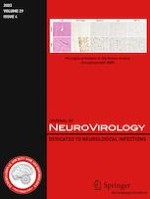Erschienen in:

24.05.2023
Microglia proliferation underlies synaptic dysfunction in the prefrontal cortex: implications for the pathogenesis of HIV-1-associated neurocognitive and affective alterations
verfasst von:
Hailong Li, Kristen A. McLaurin, Charles F. Mactutus, Rosemarie M. Booze
Erschienen in:
Journal of NeuroVirology
|
Ausgabe 4/2023
Einloggen, um Zugang zu erhalten
Abstract
Microglia, which are productively infected by HIV-1, are critical for brain development and maturation, as well as synaptic plasticity. The pathophysiology of HIV-infected microglia and their role in the pathogenesis of HIV-1-associated neurocognitive and affective alterations, however, remains understudied. Three complementary aims were undertaken to critically address this knowledge gap. First, the expression of HIV-1 mRNA in the dorsolateral prefrontal cortex of postmortem HIV-1 seropositive individuals with HAND was investigated. Utilization of immunostaining and/or RNAscope multiplex fluorescent assays revealed prominent HIV-1 mRNA in microglia of postmortem HIV-1 seropositive individuals with HAND. Second, measures of microglia proliferation and neuronal damage were evaluated in chimeric HIV (EcoHIV) rats. Eight weeks after EcoHIV inoculation, enhanced microglial proliferation was observed in the medial prefrontal cortex (mPFC) of EcoHIV rats, evidenced by an increased number of cells co-localized with both Iba1 + and Ki67 + relative to control animals. Neuronal damage in EcoHIV infected rats was evidenced by pronounced decreases in both synaptophysin and postsynaptic density protein 95 (PSD-95), markers of presynaptic and postsynaptic damage, respectively. Third, regression analyses were conducted to evaluate whether microglia proliferation mechanistically underlies neuronal damage in EcoHIV and control animals. Indeed, microglia proliferation accounted for 42–68.6% of the variance in synaptic dysfunction. Collectively, microglia proliferation induced by chronic HIV-1 viral protein exposure may underlie the profound synaptodendritic alterations in HIV-1. Understanding how microglia are involved in the pathogenesis of HAND and HIV-1-associated affective disorders affords a key target for the development of novel therapeutics.











